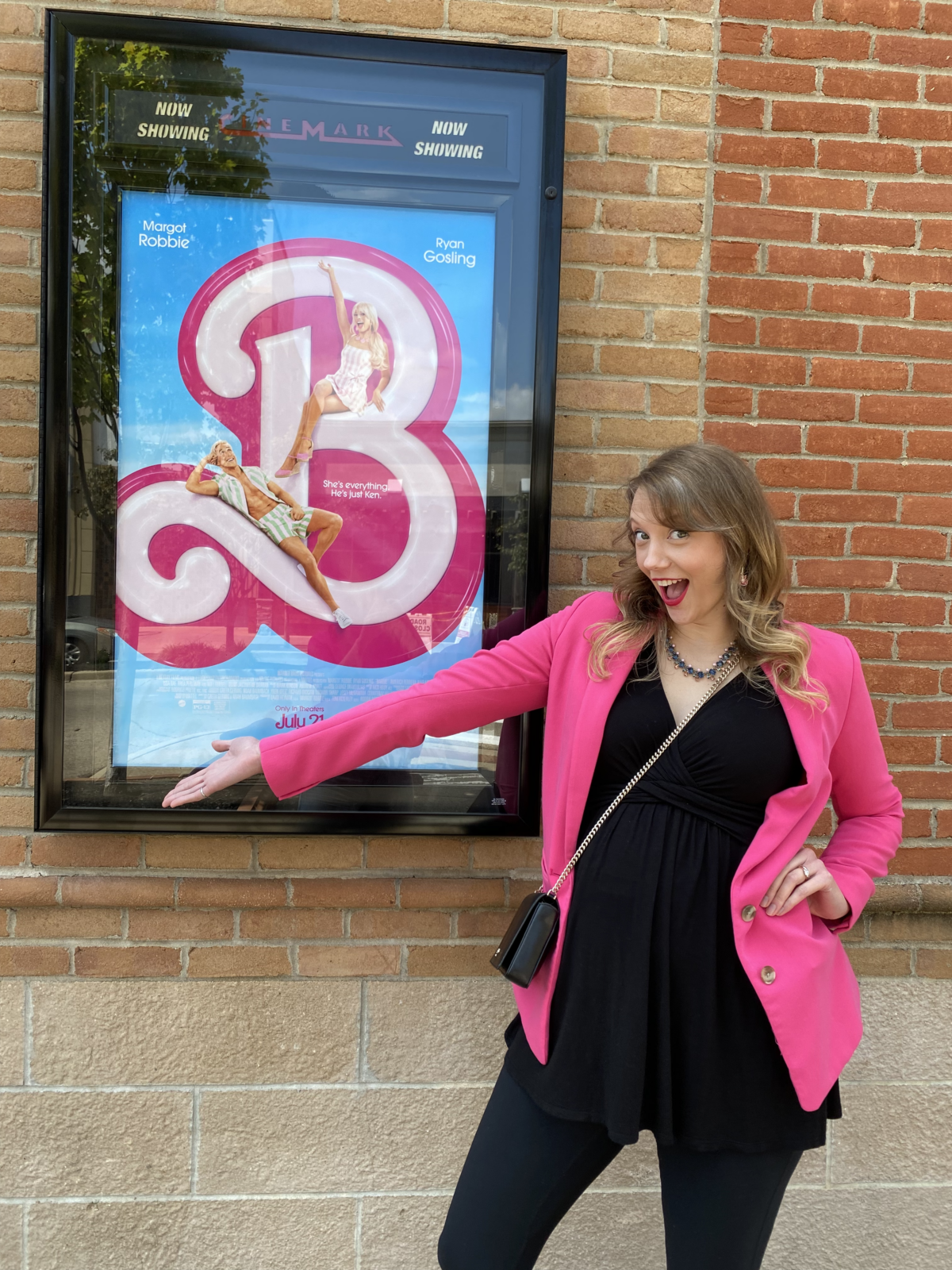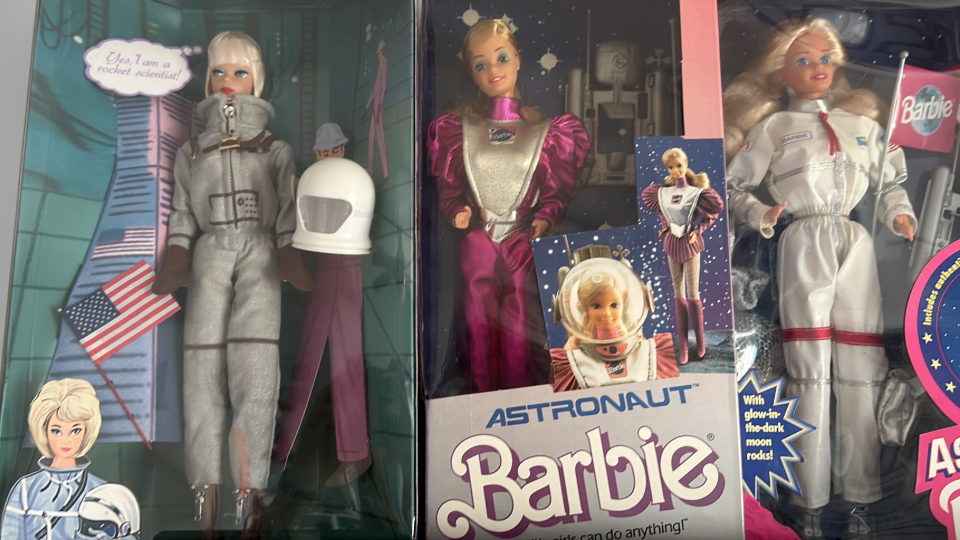At least one Embry-Riddle graduate will be cheering for Barbie during the Oscars broadcast. Kerianne Hobbs (’11) is an aerospace engineer with a doctorate, boasting over a decade of experience at the Air Force Research Lab (AFRL) and an impressive Barbie collection.
Her tongue-in-cheek self-branding as “Rocket Science Barbie” who shares the “Art of Rocket Science” on Instagram has earned her a spot in U.S. Air Force recruiting videos and garnered an Internet following for her artwork, which spans from high-tech sketches to painted dreamscapes.

When her parents asked what she wanted for Christmas her freshman year at Embry-Riddle, she jokingly replied that she wanted Astronaut Barbie. Her father surprised her with the 1994 Astronaut Barbie commemorating the 25th Anniversary of the Apollo 11 moonwalk, and it now sits displayed alongside a sisterhood of tech Barbies in her office. Her passion for science traces back to her childhood when dolls were a part of her life — albeit, probably overshadowed by books.
“I always loved science and knew from an early age that I wanted to work in aerospace,” she says.
She attended the Conroe Independent School District’s Academy of Science and Technology program in Texas, where one of her high school teachers proudly displayed pennants from universities chosen by graduates. She realized there was a school focused on aerospace when she spotted the Embry-Riddle pennant.
“I was afraid I was a bad scientist because I didn’t want to go into my garage and build things. Sketching and painting re-energize me and tap into the other side of my brain.”
— Kerianne Hobbs (’11)
She visited both the Daytona Beach Campus and the Prescott Campus and opted for the mountains over the beach. A less humid climate than her hometown of Houston appealed to her, as did the growth of the campus in 2007.
“There was a new computing center and a new library under construction and new labs that I knew I would have access to, even as an undergraduate.”
The summer before college, she interned at NASA’s Johnson Space Center, which bolstered her confidence that engineering was the right path for her.
No Dreamhouse, but a Dream Career
“At one of my first career fairs, I approached a recruiter who turned me away because they were seeking engineers,” she recalls, and she didn’t appear to fit the bill. At an Embry-Riddle career fair, she fared better, securing a co-op position. She hadn’t realized that her casual remark about being open to working in any climate would elevate her résumé to the top of the pile. For seven months, she served as an aerospace engineering co-op student at NASA’s Dryden Flight Research Center, situated on the western edge of the Mojave Desert.
Graduating with a Bachelor of Science in Aerospace Engineering in 2011 was disheartening.
“There was a recession, and the Space Shuttle program was canceled. I cast a wide net. The novelty, rapid pace, and proximity to three graduate schools made AFRL my top choice.” She has been with the lab for just over 12 years now, leading a Safe Autonomy Team focused on developing safety assurance techniques for neural network controls on air and space systems.
Early in her career, Hobbs witnessed how safety automation and monitoring systems on aircraft saved lives.
“I draw a lot of inspiration from knowing that so far, 13 highly trained pilots — Americans who risk their lives for us — are still walking around thanks to automatic collision avoidance technology,” she says. Lessons learned in the air will also protect spacecraft and satellites, as part of the lab’s expanded mission to support the U.S. Space Force and tackle challenges such as in-space servicing, assembly and manufacturing.
At the lab, she continues to embrace multiple challenges, both because she thrives on variety and because they may pave her path to a crewed spaceflight mission someday.
Despite a demanding work schedule, Hobbs earned her master’s in astronautical engineering from the Air Force Institute of Technology and a doctorate in aerospace engineering. She completed Ph.D. coursework in a year and finished her research remotely while working full-time. “There is no easy way to get a Ph.D., but I wouldn’t recommend that schedule. The Air Force paid for that year, so I am grateful for the opportunity.”
Technically, Creativity Is the Best Accessory
Her desire to inject some fun into graduate study led her to create detailed technical sketches that garnered attention. She also took up painting as a stress release and a mental shift after long days at school and in the lab.
“I draw a lot of inspiration from knowing that so far, 13 highly trained pilots — Americans who risk their lives for us — are still walking around thanks to automatic collision avoidance technology,”
— Kerianne Hobbs (’11)
“I was afraid I was a bad scientist because I didn’t want to go into my garage and build things,” she says. “Sketching and painting re-energize me and tap into the other side of my brain.” She also finds that running puts her in a flow state that enhances her problem-solving and focus.
Outreach to tomorrow’s researchers is another joy for Hobbs, who mentors interns and speaks to students about STEM careers. Her alter ego, “Rocket Science Barbie,” carries a powerful message to middle school girls who are at an age when statistically they often begin to drift away from science and math. She emphasizes that there is room for — and a need for — individuality and diversity in the sciences. She doesn’t want the next generation of women in science to feel they must conform to old “dress for success” formulas and stereotypes. Her interest in art and playful attitude reflect a conviction that there is no contradiction between working hard and having fun, personal style and professional impact, reason and emotion.
“A tech career can be creative,” she says. “People skills improve collaborations. You don’t have to be Sheldon Cooper from The Big Bang Theory. Research teams are stronger when people bring their personalities, perspectives, cultures, and hobbies into it.”
Hobbs is grateful she grew up with smart, resourceful role models, both fictional (such as Star Trek’s Capt. Kathryn Janeway) and real (Capt. Eileen Collins, the first woman to command a U.S. space shuttle). Now Hobbs is a role model herself for the next generation of engineers. “Living up to that is a little nerve-wracking,” she admits.
All-In On Aerospace
Hobbs is optimistic about the industry.
“I once thought I grew up at the wrong time. Graduated at the wrong time. Now I see a massive resurgence of space programs with a wide variety of missions. We have so much opportunity to explore and build a strong space economy,” she says.
She shares her optimism with other science enthusiasts and future colleagues. She was a speaker at the AFRL Inspire event, a TEDx-style program at the Air Force Institute of Technology at Wright-Patterson Air Force Base.
There is no official Space Force Barbie yet. However, there is shelf space waiting for her alongside Astronaut Barbie and Space Scientist Barbie in one office at the Air Force Research Lab.
